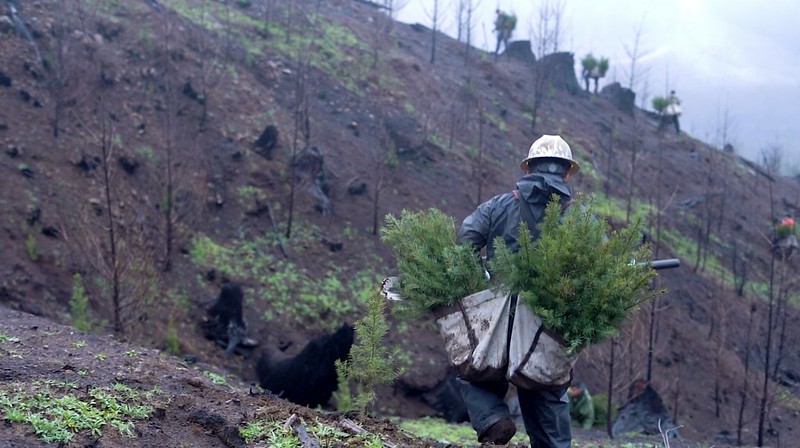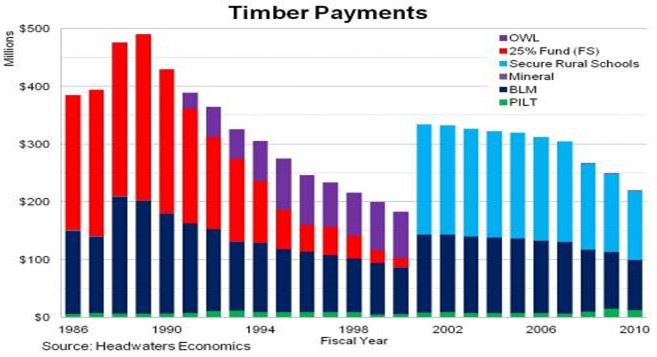This post is a response to the Elemental video that aired during the statewide Wildfire CSS virtual meeting on May 17, 2022.
As we celebrate 100 years of operation in the Santiam Canyon this year, we reflect on our roots in this canyon. We have weathered many trials over the years – including the Great Depression, the Great Recession, and the Timber Wars. The Labor Day Fires of 2020, however, were a uniquely horrifying and damaging experience for the Santiam Canyon.
When we watched the Elemental video, we did not find the video to be a fair, honest, or balanced reflection of the issues surrounding the complex scientific, social, and economic considerations to the long-term restoration or longer-term forest management issues that face the Santiam Canyon.
Wood is the most sustainable building material available to humankind. It is renewable, recyclable, solar powered, and as it grows it breathes in carbon-dioxide and breathes out oxygen; keeping the carbon in the wood as it grows over its lifetime.
During a forest lifespan, wood provides a multitude of benefits – including habitat, clean water, recreation, and amazing structural products for consumers. When compared to other building products, such as concrete or steel, wood wins hands down from an environmental perspective. Meyer Memorial Trust built their new Portland headquarters out of Mass Timber because of the environmental benefits.
If you’re interested in hearing more perspectives on the exciting, new industry of mass timber, please click to watch these on videos YouTube: Why We Should Build Wooden Skyscrapers, Why All Buildings Should Be Timber, Wooden skyscrapers could be the future for cities | The Economist.

We were considered an essential industry during the COVID-19 lockdowns, due to the many products that are manufactured and distributed through our facilities on a daily basis. All employees worked to produce electricity for the equivalent of 5,000 local homes, chips for paper products (remember the toilet paper shortage?), sawdust for particle board, bark fines for nurseries and potting soil, biochar for soil amendments, veneer for engineered wood products, commodity plywood for home construction, and Mass Ply Panels for mass timber construction.
All of these materials are produced from locally-sourced timber sold by the United States Forest Service, Bureau of Land Management, Oregon Department of Forestry, local landowners, and a small volume of our own timberlands. Each of these agencies is governed by strict environmental regulation, either on a state or federal basis, and each has contractual obligations to ensure sustainable forest management.
The timber we buy allows us to employ 420 people and provide an annual payroll of more than $26,000,000. We invest heavily back into our plants and facilities annually. In 2018, we opened the world’s first Mass Ply Panel facility, a $40,000,000 investment reaffirming our commitment to the prosperity of the Santiam Canyon. Through our local contractors, suppliers, and partners, hundreds of millions of dollars of economic benefit is generated annually.
Our single largest obstacle to more investment, more employment, and more innovative wood products is future timber supply. We were hit hard by the Beachie Creek Fire and lost 5,800 acres of timber. We aggressively salvaged dead trees and were able to recover 100 percent of the pre-fire timber inventory into wood products. We then planted 3 million seedlings to begin regrowing the forests of the future. At $1.75 per seedling, this is an investment that will not see a monetary return in our generation, or even our children’s generation, but will be available for future generations.

Our timber management is in stark contrast to that proposed in Elemental, which suggests that the 193,600 acres burned by the Beachie Creek fire are better left as standing dead trees for the foreseeable future. The fact that a fire smoldered for three weeks east of the Opal Creek wilderness on Beachie Creek, which gave the fire its name, was ignored by the video – choosing instead to blame the fires on power lines entirely.
The goal of recent litigation and injunction in the Willamette National Forest is to prohibit any beneficial rehabilitation of the burned area. The result of this litigation is restricted access to our local forests, dead and rotting trees releasing methane (a greenhouse gas with 25 times more climate impact than carbon dioxide), no recovery of dead fiber into usable products, and a much longer timeframe to reseed the land into habitats and forests. You can’t plant trees under a canopy of hazards.
There are no good outcomes from the policies proposed by Elemental. Our rural communities would remain impoverished, the standing dead trees wouldn’t be salvaged, the forest wouldn’t be renewed, and climate change will not be mitigated. If history is any guide, these standing dead trees will become the kindling for the next fire event in the Santiam Canyon and invasive species will be our next backdrop instead of a canopy of trees.
From World War 2 to the late 1980’s and 1990’s, Oregon federal forests were managed under a multiple use policy first established by Teddy Roosevelt in the early 1900’s; with the idea that a balance of uses benefits Oregon’s citizens. Some believe that the reduction of fires during this period was due to a cooling event rather than the beneficial multiple-use management of our forests and the removal of dead biomass.

Forest management since the Northwest Forest Plan can be most precisely characterized as “forest management by litigation” rather than forest management by science. We are in a 30-year experiment showing what happens in the forest when it is denied management and is forced back to natural systems. Environmental litigation has led to catastrophic mismanagement of our forest resources and unhealthy forests, which is directly responsible for the millions of forest acres destroyed in Oregon from wildfires.
Environmental promises made 30 years ago to justify the destruction of the timber industry, such as saving the Spotted Owl and old growth forests, have not come to fruition. The Spotted Owl is still in decline, even after a vast amount of land was set aside for their protection. Old growth forests such as Opal Creek, which environmental groups sought to preserve by starting the Timber Wars of the 1990’s, were destroyed in the 2020 Labor Day fires. Our forests did not become the lush utopias that were envisioned by removing human management.
Unfortunately, the NIMBY (Not In My Backyard) attitude of reducing harvest and management in our forests has encouraged the importation of wood products from the worst global actors, such as Russia, China, and Brazil. In our competitive panel markets, Brazil alone makes up 12 percent of U.S. consumption. Oregon, especially Oregon’s rural communities, pays the price in fires and poverty from the poor policies forced upon us by relentless environmental litigation and regulation driving the production of wood products overseas.

Our rural communities also depend on revenues from the harvest of timber on both federal and state lands. The Santiam Canyon School District was originally constructed with timber dollars from the timber harvest tax. Now, due to the reduction in timber harvest, the school district needed a $17 million bond to repair aging facilities for our local students. We not only supported the bond, but also provided a direct donation of almost $300,000 to the district.
We have also supported post-wildfire restoration through product donations to our local businesses and recent donations to the Santiam Canyon Wildfire Relief Fund. Timber harvest on state and federal lands are still a large source of funding for our rural counties, even with reduced levels of harvest.
I would encourage everyone to take a wider read of available science regarding the need for forest management, a message the Federal government is desperately trying to get out. At the bottom of this blog, we have listed several current peer-reviewed papers to provide a more balanced view than that provided by Professor Law.
Those of us who were in the area during the fires know how damaging the air quality was – we breathed it for weeks. The forest fires released deadly amounts of pollutants and the subsequent rotting of forest wood will further exacerbate greenhouse gas emissions. Elemental would have us believe that the carbon in dead trees will be sequestered longer than carbon stored in wood products in buildings. This is in direct contradiction to UN reports indicating the benefits of sustainable wood products production for the environment.
While Elemental insinuates that the scale of forest mismanagement is beyond repair after 30 years of neglect and we should let nature take its course, the scientific papers listed at the end of this blog indicate the disaster that would befall if we let it occur.

Oregon’s saving grace is that there are still the remains of a timber industry to help manage the forest while reducing the expense. Given the opportunity, we can help thin the forest landscape making a more resilient forest while also making products that the country needs. Our operations are ideally suited to small diameter timber from thinning projects. The Federal government just needs to make the timber sales available, and we can be part of the solution.
Please remember, we are open to our community at any time. We would be happy to take anyone on a tour for a more in-depth look at what we do. The Santiam Canyon is our home, and we want nothing more than to see prosperity return to our rural communities and have healthy forests surround us again.
For more balanced, scientific and truthful information, please read these peer-reviewed papers:
- U.S. Department of Agriculture: Evidence for widespread changes in the structure, composition, and fire regimes of western North American forests
- U.S. Forest Service: Climate and wildfire adaptation of inland Northwest US forests
- U.S. Forest Service: Adapting western North American forests to climate change and wildfires: 10 common questions
Subscribe
We’ll send you a notification when a new story has been posted. It’s the easiest way to stay in the know.